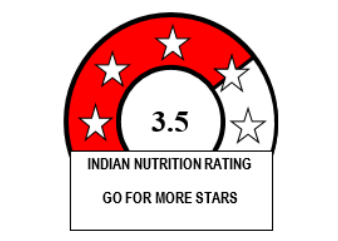Know how Front of Pack Labelling will impact Farmer Producer Organizations
October 26, 2022

The much-awaited, anticipated and even feared by a few Food Manufacturers- Front of Pack Labelling was introduced by the Food Safety and Standards Authority of India (FSSAI) in its draft Regulation on 13th September 2022. The move was to strengthen the Food Labelling ecosystem in India and to offer quick guidance to consumers on the nutrition profile of Packaged Foods. Very soon we will get to see a packet of chips or biscuits mentioning the health stars (out of 5) on its front panel. While most countries such as Australia, New Zealand, Chile, Israel, Peru, Brazil, and Mexico, among others, already have a range of front-of-pack-labelling which indicates to the consumer in 10 seconds how healthy the product is. India too will follow suit, and in a couple of years, the supermarket will be flooded with products denoting the front of the pack label.
What is Front-of-pack nutrition labelling?
As per the definition given by FSSAI: “Front-of-pack nutrition labelling (FOPNL) is a form of supplementary nutrition information that presents simplified nutrition information on the front-of-pack of pre-packaged foods. It can include symbols/graphics, text or a combination thereof that provide information on the overall nutritional value of the food and/or on nutrients included in the FOPNL.” It is quick and easy-to-understand information for consumers at the point of purchase, allowing them to distinguish between healthy and unhealthy food and drink options. Simply put, general people need a clear and easy way to make healthier purchases.
The chosen method by FSSAI to denote this simplified nutrition information on the front panel is through Health Star Rating introduced and adopted by Australia & New Zealand. In the Indian Context, it is named Indian Nutrition Rating (INR), a system wherein product is rated on nutrition parameters and stars are assigned from ½ star (least healthy) to 5 stars (healthiest). More stars indicate that the food product is better positioned to provide for the daily human need for nutrients. The logo format for INR is shown below:
To know more on FOPNL, refer blog: FSSAI Front of Pack Labelling in India
The chosen method by FSSAI to denote this simplified nutrition information on the front panel is through Health Star Rating introduced and adopted by Australia & New Zealand. In Indian Context, it is named as Indian Nutrition Rating (INR), a system wherein product is rated on nutrition parameters and stars are assigned from ½ star (least healthy) to 5 stars (healthiest). More stars indicate that the food product is better positioned to provide for daily human need of nutrients. The logo format for INR is shown below:

To know more on the study for FOPNL refer blog: FNB News - FSSAI assigned LabelBlind to study baseline nutrition values of packed food products | FNB News
But why Front-of-pack nutrition labelling?
The processed Food Market in India has a 24% growth year on year and is expected to rise further. With urbanization and increased affordability, the food environment in India has changed from traditional home food to more packed, ready-to-eat, snacking and junk food varieties. This has increased lifestyle-related health conditions such as diabetes, obesity and heart conditions. It raises serious concerns about the well-being of average Indians and the future population. FSSAI has recognized the same and hence has introduced the FOPNL. This INR system will help in choosing foods carefully and is preventive in nature for foods that are high fat, high sugar and high salt. Just the way a packet of cigarettes has a warning message which helps discourage its consumption, in the same way, FOPNL will encourage consumers to buy products with more stars. This will not only educate consumers on choosing healthy packaged products but will also keep Food manufacturers on their toes to better their product formulations to achieve more stars. Research conducted on Dutch products showed that many food products were reformulated to denote a better score.
To know more about the impact of FOPNL on consumers refer blog: How do Front-of-Package Nutrition Labels impact consumers?
How will Front-of-pack nutrition labelling impact Farmer Producer organizations (FPOs)?
Farmer Producer Organizations are organisations of farmers, who produce agricultural products. Most of these agricultural products include grains, fruits, vegetables, honey and spices and their products. As per the law, single-ingredient items are exempted from FOPNL. Please find the list below describing the categories exempted from FOPNL.
List of Categories exempted from Front-of-pack nutrition labelling:
1.1.1 Milk and buttermilk [1.1.1.1 Milk (plain), 1.1.1.2 Buttermilk (plain)]
1.2 Fermented and renneted milk products (plain), excluding food category [1.2.1 Fermented milk (plain), 1.2.2 Renneted milk (plain)]
1.3 Condensed milk and analogues (plain)
1.4 Cream (plain) and the like cream and malai
1.5 Milk powder and cream powder and powder analogues (plain)
1.8 Whey and whey products, excluding whey cheeses
2.1 Fats and oils essentially free from water
2.3 Fat emulsions mainly of type oil-in-water, including mixed and/or flavoured products based on fat emulsions
4.1.1 Fresh fruit
4.1.2.1 Frozen fruit
4.2.1 Fresh vegetables, (including mushrooms and fungi, roots and tubers, pulses and legumes, and aloe vera), seaweeds and nuts and seeds [4.2.2.1 Frozen vegetables (including mushrooms and fungi, roots and tubers, pulses and legumes, and aloe vera), seaweeds and nuts and seeds]
5.1.1 Cocoa mixes (powders) and cocoa mass/cake
5.1.2 Cocoa mixes (syrups)
6.1 Whole, broken or flaked grain, including rice
6.2 Flours and starches (including soybean powder)
6.6 Batters
8.1 Fresh meat and poultry [8.1.1 Fresh meat and poultry whole pieces or cuts, 8.1.2 Fresh meat and poultry comminuted]
8.3.3 Frozen processed comminuted meat and poultry products
8.4 Edible casings (e.g., Sausage casings)
9.1 Fresh fish and fish products, including molluscs, crustaceans, and echinoderms [9.1.1 Fresh fish, 9.1.2 Fresh molluscs, crustaceans, and echinoderms]
10.0 Eggs and egg products [Entire]
11 Sweeteners, including honey [Entire]
12.1 Salt and salt substitutes
12.2 Herbs, spices, seasonings and condiments (e.g. seasoning for instant noodles)
12.3 Vinegar
12.4 Mustards
12.7 Salads and sandwich spreads excluding cocoa-and nut-based spreads of food categories 4.2.2.5 and 5.1.3
12.8 Yeast and like products
12.10 Protein products other than soybeans
13 Foodstuffs intended for particular nutritional uses [Entire]
14.1.1 Waters
14.2 Alcoholic beverages, including alcohol-free and low-alcoholic counterparts
FOPNL will not impact single ingredient products. However, single ingredient products that have a presence in composite products must consider the following factors:
Single ingredients in composite products will impact their INR score across the 10 parameters of the Indian Nutrition Rating (HFSS is High Fat, Sugar, Salt; FVNL is Fruit, Vegetable, Nut, Legume; Protein and Fibre).
Single-ingredient exempted categories will need FOPNL assessment to support the nutritional values of the composite and processed food markets.
Examples are the presence of nuts and fruits in bakery products, and the presence of cereals and grains in snacks and breakfast cereals. Such Processed Food Manufacturers would seek single ingredients with better quality and nutrition and higher INR score. FPOs must therefore ensure to get products nutritionally assessed for physical quality and nutrition quality so as to stay compliant and relevant in the market.
Conclusion
FOPNL is a new regulation brought by FSSAI for all packaged food manufacturers that allow consumers to view the nutrition profile of a product in just a few seconds. This is thought to impact consumers on their eating choices, selection of healthy products and Food manufacturers to reformulate their products so as to achieve more stars. Farmer Producer Organizations will also be impacted by this law as they rule the single-ingredient product market that makes up processed food products. As these composite foods companies would be interested to increase their stars on the pack by bringing in quality ingredients, FPOs would have to ensure nutrition quality and compliance are in place to stay relevant. However, only time will tell how this new regulation brings about positive change in the market!
Also Read - Know how Front of Pack Labelling will impact Food Ecommerce Businesses & Food Aggregators
References:
FSSAI introduces Front of package label campaign (packagingsouthasia.com)
Colour coding or star rating—FSSAI food labelling plan can trigger a new nutrition war (theprint.in)
FSSAI Food Safety and Standards (Labelling and Display) Regulations, 2020.
4 Reasons to Adopt Front-of-Package Nutrition Labels (ama.org)

Olivia Crasto (MSc in Food Processing & Preservation)
Olivia is a Learner for Life, Eco enthusiast and loves to experience nature and its beauty
